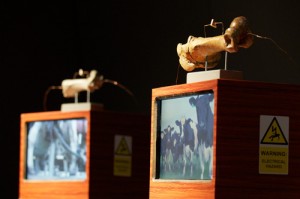For the 2010 review I managed to fold my FrogHeart overview into a roundup of Canadian science blogs but this year, there were so many blogs they got one posting all to themselves.
I think I’ll get the numbers part of this out of the way first. Overall, I have almost doubled my numbers (AW Stats) from 25,935 in Dec. 2010 to over 50,000 in Dec. 2011 (I’ll give a more accurate tally once the month is complete). (ETA Feb. 2, 2012: There were 53,488 visits.) My biggest month was November with over 54,000 visits and some 19,489 unique visitors. The numbers did not increase as rapidly as they did in previous years but I guess that’s what happens as your blog gets bigger. I was surprised to notice that major events tended to have an impact. For example, the Arab Spring, the Fukushima nuclear incident, Jack Layton’s death and other important events affected the number of visits (fewer) here. For my annual AW statistic, I’ll have had over 480,000 visits. (ETA Feb. 2, 2012: The final numbers were 482,144.)
As for my Webalizer statistics, they too show that November 2011 was my busiest month with some 78,379 visits. (ETA Feb. 2, 2012: December 2011 was the busiest month with 81, 224 visits.) It’s not possible to compare this number with my 2010 statistics as my webhosting service missed two weeks of Webalizer statistics in November 2010. My annual Webalizer statistic for visits will be over 727,000. (ETA Feb. 2, 2012: Not sure what happened but my final numbers were 678,078.) As I understand it, my Webalizer statistics include bots, crawlers, etc. that are not included in my AW statistics.
The most popular topic on my blog continues to be nanocrystalline cellulose; every single month this year it has been one of the top 10 keyterm searches. Also popular is the Urbee (a ‘green’ car being developed in Winnipeg, Manitoba) and literary tattoos. Silver nanoparticles and titanium dioxide also pop up with some regularity in the top 10 keyterm searches. Other popular stories include the Lycurgus cup, the ‘nanotechnology protest bombings in Mexico, the physics of Jackson Pollock, and the annual Brackendale eagle count.
I was able to feature several interviews on this year’s blog:
- Darren Anderson and Keith Thomas of Vive Crop (formerly Vive Nano) about their company
- Heather Graves (arts scholar in residence at Canada’s National Institute of Nanotechnology) about being the 1st such scholar
- Julie Freeman (visual artist) about her ‘nano’ pieces which were shown in the UK’s House of Lords
- Dr. Seyed Gh. Etemad about the International Conference on Nanotechnology: Fundamentals and Applications
- Baba Brinkman (a Vancouver-based rapper) about performing the Rap Guide to Evolution, the only peer-reviewed rap in the world
- Mark MacLachlan (professor at the University of British Columbia) about his work using nanocrystalline cellulose to create iridescent films
- Dr. Helen Beady of the Memphis Zoo discussing her nano zoo project
- Tim Harper, CEO of Cientfica, a consulting firm, about his white paper on global nanotechnology funding and economic impacts
- Jim Kor project leader and lead designer about the Urbee car
- Dr. Andrew Maynard commented on Health Canada’s definition for nanomaterials
- Dr. David Kent, postdoc researcher and blogger at The Black Hole, about his presentation on prospects for science graduates at the 2011 Canadian Science Policy Conference
- Dr. Tim Meyer, TRIUMF, about his presentation on public outreach and ‘big science’ at the 2011 Canadian Science Policy Conference
- Dr. Maria DeRosa and her work with aptamers at Carleton University in Ottawa
- Mike Harcourt, former Premier of BC, former Mayor and Councillor for the City of Vancouver, about his presentation on building stronger communities through innovation at the 2011 Canadian Science Policy Conference
- Denise Amyot, CEO of the Canada Science and Technology Museums Corporation, about her presentation on science culture at the 2011 Canadian Science Policy Conference
Thank you all for taking the time out of your very busy schedules to respond to my questions. If I’ve forgotten any interviews, please do let me know. (I don’t always remember to tick off the Interview category before I post.)
I did present at one conference this year, Northern Voice (blogging conference held in Vancouver annually) in May 2011 on a Canadian science blogging panel. My panel featured Rosie Redfield (RRResearch), Beth Snow (The Black Hole), and Eric Michael Johnson (The Primate Diaries). I also produced two videos and had a paper (Whose electric brain?) accepted for the 2011 ISEA conference Istanbul, which I was unable to attend but I did raise some funds and hope to use those for a presentation of the paper elsewhere.
There was a bit of a kerfuffle with the El Naschie story (he’s suing Nature for libel in the UK) resulting in some lively discussion about the merits of his case and some soul searching on my part as I try to establish both an open and civil environment here.
Thanks to my international colleagues who inspire and keep me apprised of the latest information on nanotechnology and other emerging technologies:
- Pasco Phronesis, owned by David Bruggeman, focuses more on science policy and science communicati0n (via popular media) than on emerging technology per se but David provides excellent analysis and a keen eye for the international scene.
- Nanoclast is on the IEEE (Institute of Electrical and Electronics Engineers) website and features Dexter Johnson’s writing on nanotechnology government initiatives, technical breakthroughs, and, occasionally, important personalities within the field. I don’t always agree with Dexter but he’s always thoughtful and thought-provoking. He fills in an important gap in a lot of nanotechnology reporting with his intimate understanding of the technology itself.
- TNTlog is Tim Harper’s (CEO of Cientifica) blog features an international perspective (with a strong focus on the UK scene) on emerging technologies and the business of science. His writing style is quite lively (at times, trenchant) and it reflects his long experience with nanotechnology and other emerging technologies.
- 2020 Science is Dr. Andrew Maynard’s (director of University of Michigan’s Risk Science Center) more or less personal blog. An expert on nanotechnology (he was the Chief Science Adviser for the Project on Emerging Nanotechnologies, located in Washington, DC), Andrew writes extensively about risk, uncertainty, nanotechnology, and the joys of science. Over time his blog has evolved to include the occasional homemade but science-oriented video, courtesy of one of his children. I usually check Andrew’s blog when there’s a online nanotechnology kerfuffle as he usually has the inside scoop.
- nanopublic is Dr. Dietram Scheufele’s (University of Wisconsin-Madison) blog. He doesn’t post there as frequently as he did but it’s always worth a visit. His focus is on public opinion, media, and emerging (communication) technologies. He first came to my notice (and many others) with a presentation at the American Association for the Advancement of Science (AAAS) annual meeting where he discussed the impact that religious and other values have on public opinion on nanotechnology.
- NanoWiki is, strictly speaking, not a blog but the authors provide the best compilation of stories on nanotechnology issues and controversies that I have found yet. Here’s how they describe their work, “NanoWiki tracks the evolution of paradigms and discoveries in nanoscience and nanotechnology field, annotates and disseminates them, giving an overall view and feeds the essential public debate on nanotechnology and its practical applications.” There are also Spanish, Catalan, and mobile versions of NanoWiki.
Thank you to all my commenters for taking the time to comment about what you found here and to all of my readers for taking the time to check out this blog.
I have been on Twitter (@frogheart) for my first full year (I joined in Aug. 2010) and found it to be a great source of information and entertainment. These days frogheart has over 200 followers and follows some 250 tweeters. Thanks to Ruth Seeley (@ruthseeley) for inviting me to join Twitter and other science tweeters.

